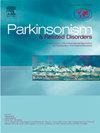Objective real-world mobility patterns in Parkinson's disease: Driving and walking after levodopa dosing
IF 3.4
3区 医学
Q2 CLINICAL NEUROLOGY
引用次数: 0
Abstract
Introduction
Levodopa is the primary treatment for motor symptoms in Parkinson's disease (PD), yet its real-world effects on activities of daily living (ADLs) across the day remain unclear. This study used continuous real-world monitoring to examine how levodopa dosing influences walking (basic ADL) and driving (instrumental ADL) in individuals with PD.
Methods
In a four-week observational study, 24 participants with early-stage PD underwent continuous monitoring of walking and driving using in-vehicle sensors, wrist-worn actigraphy, and medication logs. Activity was analyzed in 30-min intervals up to 4 h post-dose. Mixed-effects models assessed associations between time since last dose and activity, stratified by morning (wake to 1 p.m.) and afternoon (1 p.m. to bedtime), adjusting for age, sex, employment, motor severity, and levodopa equivalent daily dose (LEDD).
Results
Morning activity increased significantly post-medication, peaking at 120–150 min. Afternoon activity declined: driving likelihood decreased by 120 min, and walking declined by 180 min, reaching the lowest levels at 210–240 min. Higher motor symptom severity (MDS-UPDRS Part III) was associated with reduced walking but not driving.
Conclusion
Real-world mobility data reveal distinct time-of-day patterns in levodopa's effects. Morning doses yielded greater benefit, while afternoon effects diminished. Aligning medication timing with functional demands and integrating continuous monitoring may improve PD management.
帕金森病的客观现实世界活动模式:左旋多巴给药后开车和走路
左旋多巴是帕金森病(PD)运动症状的主要治疗方法,但其对日常生活活动(adl)的实际影响尚不清楚。本研究使用连续的现实世界监测来检查左旋多巴剂量如何影响PD患者的步行(基本ADL)和驾驶(工具性ADL)。方法在一项为期四周的观察性研究中,24名早期PD患者使用车载传感器、腕带活动记录仪和用药记录对步行和驾驶进行持续监测。每隔30分钟至给药后4小时分析活性。混合效应模型评估了自上次给药以来的时间与活动之间的关系,按上午(起床至下午1点)和下午(下午1点至就寝时间)分层,调整了年龄、性别、职业、运动严重程度和左旋多巴当量日剂量(LEDD)。结果给药后晨起活动明显增加,在120 ~ 150 min达到高峰。下午活动减少:驾车可能性减少120分钟,步行可能性减少180分钟,在210-240分钟达到最低水平。较高的运动症状严重程度(MDS-UPDRS Part III)与步行减少有关,但与驾驶无关。结论真实世界的移动数据揭示了左旋多巴影响的不同时间模式。早上服用效果更好,而下午服用效果则会减弱。将用药时间与功能需求相结合并整合持续监测可改善帕金森病的治疗。
本文章由计算机程序翻译,如有差异,请以英文原文为准。
求助全文
约1分钟内获得全文
求助全文
来源期刊

Parkinsonism & related disorders
医学-临床神经学
CiteScore
6.20
自引率
4.90%
发文量
292
审稿时长
39 days
期刊介绍:
Parkinsonism & Related Disorders publishes the results of basic and clinical research contributing to the understanding, diagnosis and treatment of all neurodegenerative syndromes in which Parkinsonism, Essential Tremor or related movement disorders may be a feature. Regular features will include: Review Articles, Point of View articles, Full-length Articles, Short Communications, Case Reports and Letter to the Editor.
 求助内容:
求助内容: 应助结果提醒方式:
应助结果提醒方式:


